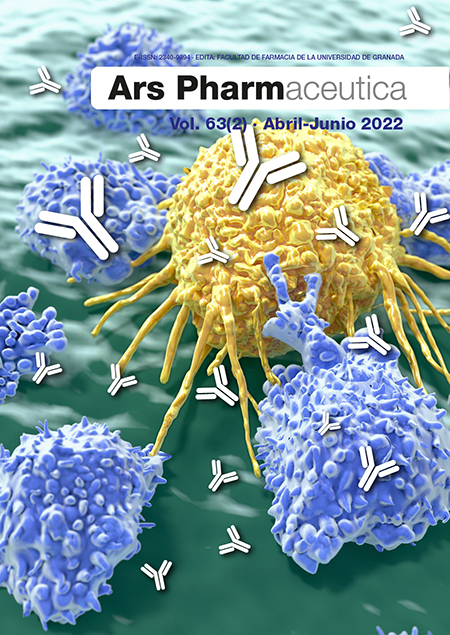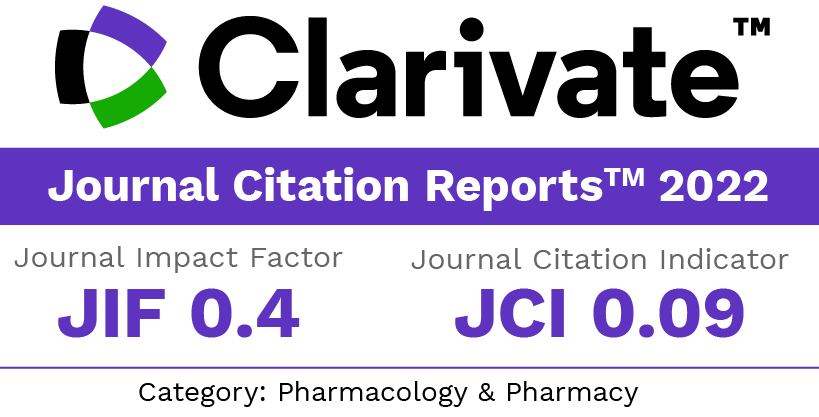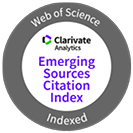Naringin: antitumor potential in silico and in vitro on bladder cancer cells
DOI:
https://doi.org/10.30827/ars.v63i2.22430Keywords:
cell cycle progression, flavonoid, in silico, naringin, bladder cancerAbstract
Introduction: Urothelial carcinoma is a significant public health problem. Transitional cell carcinoma (TCC) is the most common subtype, accounting for approximately 90 % of all bladder cancers. Chemotherapeutic protocols have been studied, but some present high toxicity and low tolerability. Naringin is a polyphenolic compound found mainly in citrus fruits, which antitumor activity has been studied in several types of cancer. However, there is little information about naringin effects on bladder cancer. This study aimed to evaluate the antitumor potential of naringin in silico and in vitro using two bladder cancer cell lines
Method: In silico analysis was carried out by PASS Online software. In vitro, the effects of naringin treatment (12.5 - 400 µM) were evaluated regarding its cytotoxicity, clonogenic survival, morphological alterations, cell cycle progression, migration, and mutagenicity
Results: In silico analyses predicted antitumor activity through several mechanisms of action. In vitro results showed naringin presented cytotoxic effects, reduced the number of colonies, inhibited cell migration, and changed the morphology and cell cycle progression of the two cell lines evaluated. However, naringin did not present mutagenic effects.
Conclusions: Naringin has antiproliferative activity and is a promising candidate for bladder cancer treatment.
Downloads
References
Ferlay J, Colombet M, Soerjomataram I, Parkin DM, Piñeros M, Znaor A, et al. Cancer statistics for the year 2020: An overview. Int J Cancer. 2021;144(8):1941-1953. doi: 10.1002/ijc.31937
Sanli O, Dobruch J, Knowles MA, Burger M, Alemozaffar M, Nielsen ME, et al. Bladder cancer. Nat Rev Dis Primers. 2017;3(17022):1-19. doi: 10.1038/nrdp.2017.22
Chang SS, Bochner BH, Chou R, Dreicer R, Kamat AM, Lerner SP, et al. Treatment of non-metastatic muscle-invasive bladder cancer: AUA/ASCO/ASTRO/SUO Guideline. J Urol. 2017;198(3):552-559. doi: 10.1016/j.juro.2017.04.086
Lin SR, Chang CH, Hsu CF, Tsai MJ, Cheng H, Leong MK, et al. Natural compounds as potential adjuvants to cancer therapy: Preclinical evidence. Br J Pharmacol. 2020;177(6):1409-1423. doi: 10.1111/bph.14816
Dutta S, Mahalanobish S, Saha S, Ghosh S, Sil PC. Natural products: An upcoming therapeutic approach to cancer. Food Chem Toxicol. 2019;128:240-255. doi: 10.1016/j.fct.2019.04.012
Chen R, Qi QL, Wang MT, Li QY. Therapeutic potential of naringin: an overview. Pharm Biol. 2016;54(12):3203-3210. doi: 10.1080/13880209.2016.1216131
Ghanbari-Movahed M, Jackson G, Farzaei MH, Bishayee A. A systematic review of the preventive and therapeutic effects of naringin against human malignancies. Front Pharmacol. 2021;12:639840. doi: 10.3389/fphar.2021.639840
Kim DI, Lee SJ, Lee SB, Park K, Kim WJ, Moon SK. Requirement for Ras/Raf/ERK pathway in naringin-induced G1-cell-cycle arrest via p21WAF1 expression. Carcinogenesis. 2008;29(9):1701-1709. doi: 10.1016/j.prnil.2017.11.001
Pereira GLDC, Almeida TC, Seibert JB, Amparo TR, Soares RDOA, Rodrigues IV, et al. Antitumor effect of Cymbopogon densiflorus (Linneu) essential oil in bladder cancer cells. Nat Prod Res. 2020; 2:1-5. doi: 10.1080/14786419.2020.1747453
Da Silva GN, de Castro Marcondes JP, de Camargo EA, Junior GASP, Sakamoto-Hojo, Salvadori DMF. Cell cycle arrest and apoptosis in TP53 subtypes of bladder carcinoma cell lines treated with cisplatin and gemcitabine. Exp Biol Med (Maywood). 2010;235(7):814-824. doi: 10.1258/ebm.2010.009322
Lima APB, Almeida TC, Barros TMB, Rocha LCM, Garcia CCM, Da Silva GN. Toxicogenetic and antiproliferative effects of chrysin in urinary bladder cancer cells. Mutagenesis. 2020;1(5):1-11. doi: 10.1093/mutage/geaa021
Sávio ALV, Da Silva GN, Salvadori DMF. Inhibition of bladder cancer cell proliferation by allyl isothiocyanate (mustard essential oil). Mutat Res. 2015;771:29-35. doi: 10.1016/j.mrfmmm.2014.11.004
Da Silva GN, De Camargo EA, Salvadori DMF. Toxicogenomic activity of gemcitabine in two TP53-mutated bladder cancer cell lines: special focus on cell cycle-related genes. Mol Biol Rep. 2012;39(12):10373-10382. doi: 10.1007/s11033-012-1916-1
Almeida TC, Guerra CCC, De Assis BLG, Soares RDOA, Garcia CCM, Lima AAL, et al. Antiproliferative and toxicogenomic effects of resveratrol in bladder cancer cells with different TP53 status. Environ Mol Mutagen. 2019;60(8):740-751. doi: 10.1002/em.22297
Barros TMB, Lima APB, Almeida TC, Da Silva GN. Inhibition of urinary bladder cancer cell proliferation by silibinin. Environ Mol Mutagen. 2020;61(4):445-455. doi: 10.1002/em.22363
Fenech M. The in vitro micronucleus technique. Mutat Res. 2000;455(1-2):81-95. doi: 10.1016/s0027-5107(00)00065-8
Achary PGR. Applications of quantitative structure-activity relationships (QSAR) based virtual screening in drug design: A review. Mini Rev Med Chem. 2020;20(14):1375-1388. doi: 10.2174/1389557520666200429102334
Elmore S. Apoptosis: A review of programmed cell death. Toxicol Pathol. 2007;35(4):495-516. doi: 10.1080/01926230701320337
Slee EA, Adrain C, Martin SJ. Executioner caspase-3, -6, and -7 perform distinct, non-redundant roles during the demolition phase of apoptosis. J Biol Chem. 2001;276:7320-7326. doi: 10.1074/jbc.M008363200
Banjerdpongchai R, Wudtiwai B, Khawon P. Induction of human hepatocellular carcinoma HepG2 cell apoptosis by naringin. Asian Pac J Cancer Prev. 2016;17(7):3289-3294.
Tsuboi A, Ohsawa S, Umetsu D, Sando Y, Kuranaga E, Igaki T, et al. Competition for space is controlled by apoptosis-induced change of local epithelial topology. Curr Biol. 2018;28(13):2115-2128. doi: 10.1016/j.cub.2018.05.029
Xu X, Lai Y, Hua ZC. Apoptosis and apoptotic body: disease message and therapeutic target potentials. Biosci Rep. 2019;39(1):1-17. doi: 10.1042/BSR20180992
Munshi A, Hobbs M, Meyn RE. Clonogenic cell survival assay. Methods Mol Med. 2005;110:21-28. doi: 10.1385/1-59259-869-2:021
Tannock IF, Lee C. Evidence against apoptosis as a major mechanism for reproductive cell death following treatment of cell lines with anti-cancer drugs. Br J Cancer. 2001;84:100-105. doi: 10.1054/bjoc.2000.1538
Xu C, Huang X, Huang Y, Liu X, Wu M, Wang J, et al. Naringin induces apoptosis of gastric carcinoma cells via blocking the PI3K/AKT pathway and activating pro‑death autophagy. Mol Med Rep. 2021;24(5):772. doi: 10.3892/mmr.2021.12412
Lin R, Hu X, Chen S, Shi Q, Chen H. Naringin induces endoplasmic reticulum stress-mediated apoptosis, inhibits β-catenin pathway and arrests cell cycle in cervical cancer cells. Acta Biochim Pol. 2020;67(2):181-188. doi: 10.18388/abp.2020_5182
Li H, Yang B, Huang J, Xiang T, Yin X, Wan J, et al. Naringin inhibits growth potential of human triple-negative breast cancer cells by targeting β-catenin signaling pathway. Toxicol Lett. 2013;220(3):219-228. doi: 10.1016/j.toxlet.2013.05.006
Walz S, Lorenzin F, Morton J, Wiese KE, Eyss BV, Herold S, et al. Activation and repression by oncogenic MYC shape tumour-specific gene expression profiles. Nature. 2014;511:483-487. doi: 10.1038/nature13473
Zhou J, Xia L, Zhang Y. Naringin inhibits thyroid cancer cell proliferation and induces cell apoptosis through repressing PI3K/AKT pathway. Pathol Res Pract. 2019;215(12):152707. doi: 10.1016/j.prp.2019.152707
Aroui S, Aouey B, Chtourou Y, Meunier AC, Fetoui H, Kenani A. Naringin suppresses cell metastasis and the expression of matrix metalloproteinases (MMP-2 and MMP-9) via the inhibition of ERK-P38-JNK signaling pathway in human glioblastoma. Chem Biol Interact. 2016;244:195-203. doi: 10.1016/j.cbi.2015.12.011
Ming H, Chuang Q, Jiashi W, Bin L, Guangbin W, Xianglu J. Naringin targets Zeb1 to suppress osteosarcoma cell proliferation and metastasis. Aging. 2018;10(12):4141-4151. doi: 10.18632/aging.101710
Tan TW, Chou YE, Yang WH, Hsu CJ, Fong YC, Tang CH. Naringin suppress chondrosarcoma migration through inhibition vascular adhesion molecule-1 expression by modulating miR-126. Int Immunopharmacol. 2014;22(1):107-114. doi: 10.1016/j.intimp.2014.06.029
Saleh M, Khalil M, Abdellateif MS, Ebeid E, Madney Y, Kandeel EZ. Role of matrix metalloproteinase MMP-2, MMP-9 and tissue inhibitor of metalloproteinase (TIMP-1) in the clinical progression of pediatric acute lymphoblastic leukemia. Hematology. 2021;26(1):758-768. doi: 10.1080/16078454.2021.1978763
Zhu J, Li Y, Chen C, Ma J, Sun W, Tian Z, et al. NF-κB p65 overexpression promotes bladder cancer cell migration via FBW7-mediated degradation of RhoGDIα protein. Neoplasia. 2017;19(9):672-683. doi: 10.1016/j.neo.2017.06.002
Bacanli M, Başaran AA, Başaran N. The antioxidant and antigenotoxic properties of citrus phenolics limonene and naringin. Food Chem Toxicol. 2015;81:160-170. doi: 10.1016/j.fct.2015.04.01
Published
How to Cite
Issue
Section
License
Copyright (c) 2022 Gustavo Souza, Glenda da Silva

This work is licensed under a Creative Commons Attribution-NonCommercial-ShareAlike 4.0 International License.
The articles, which are published in this journal, are subject to the following terms in relation to the rights of patrimonial or exploitation:
- The authors will keep their copyright and guarantee to the journal the right of first publication of their work, which will be distributed with a Creative Commons BY-NC-SA 4.0 license that allows third parties to reuse the work whenever its author, quote the original source and do not make commercial use of it.
b. The authors may adopt other non-exclusive licensing agreements for the distribution of the published version of the work (e.g., deposit it in an institutional telematic file or publish it in a monographic volume) provided that the original source of its publication is indicated.
c. Authors are allowed and advised to disseminate their work through the Internet (e.g. in institutional repositories or on their website) before and during the submission process, which can produce interesting exchanges and increase citations of the published work. (See The effect of open access).























